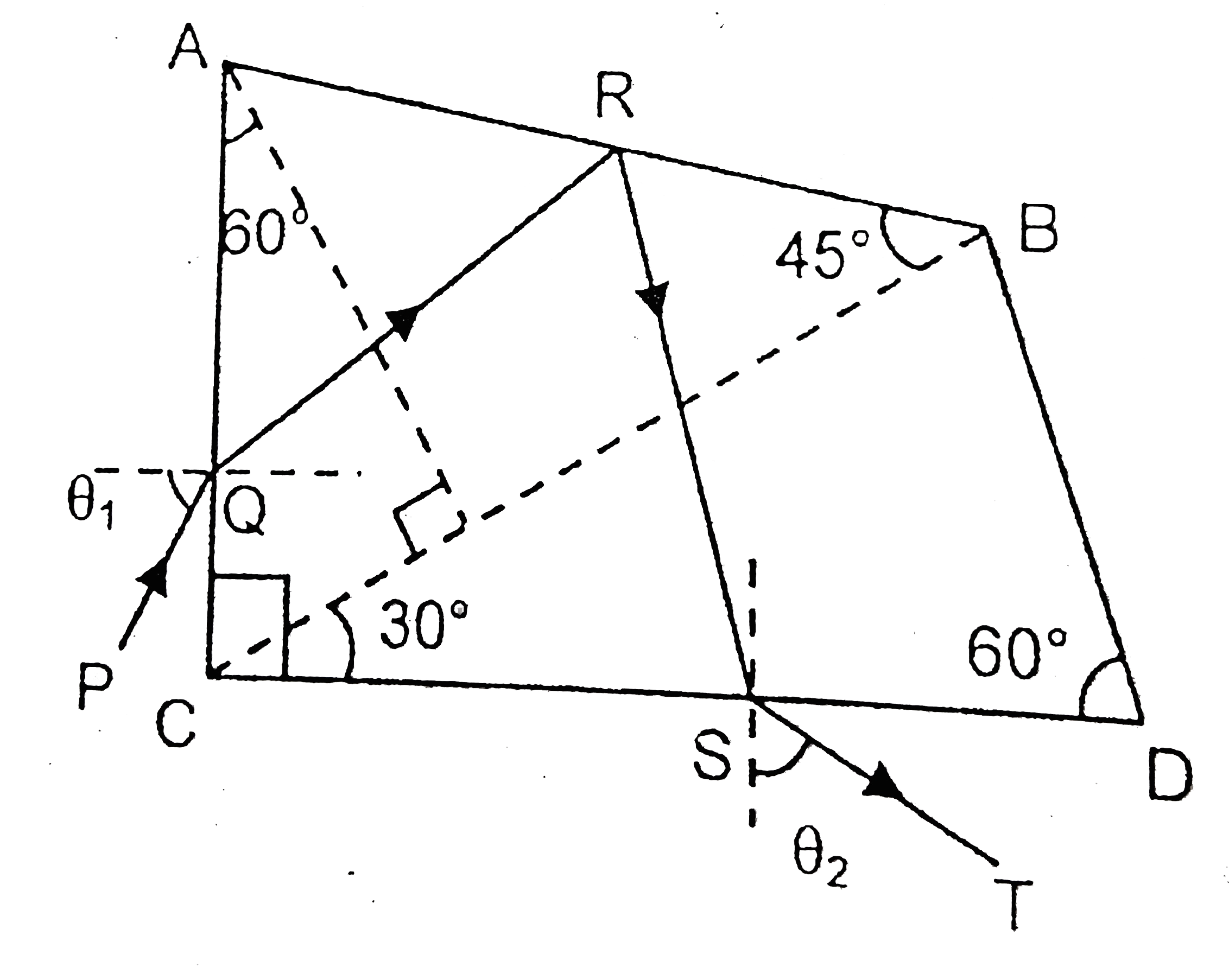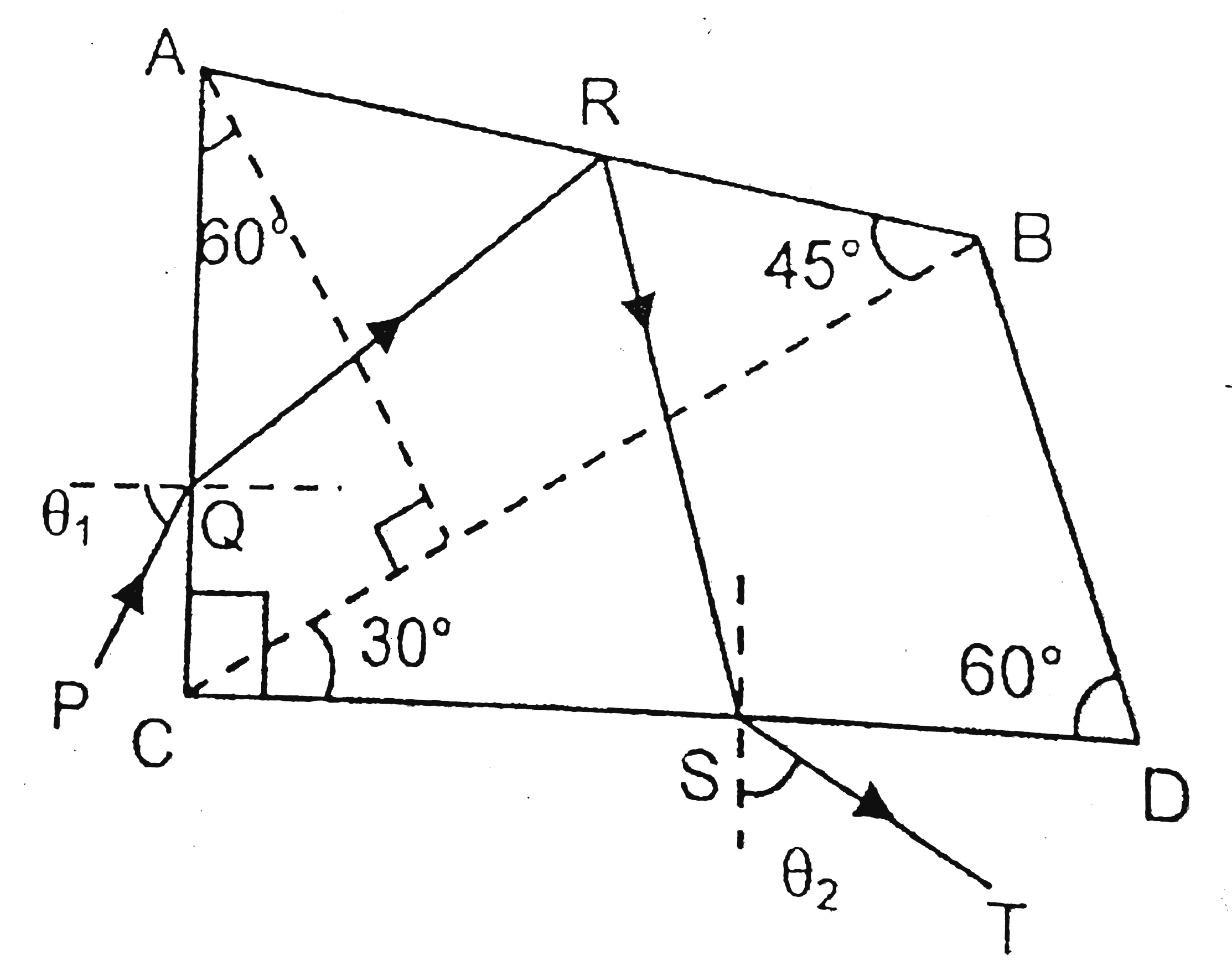Read the paragraph and the figure carefully and answer the questions.

The figure shows a constant deviation prism ABCD. The incident ray is PQ and the emergent ray is ST. Although it is made up of one piece of glass, it is equivalent to two 30∘−60∘−90∘ prisms and one 45∘−45−90∘ prism. The angle θ1 is the angle of incidence on face AB. The path of the ray inside the prism is indicated in the figure.
For this prism, μ=2sinθ1
The angle of refraction on the face AB is
30∘
45∘
15∘
40∘
The correct Answer is:A
Topper's Solved these Questions
- RAY OPTICSBOOK - CENGAGE PHYSICSCHAPTER - RAY OPTICSEXERCISE - DPP 1.6
12 Videos
- RAY OPTICSBOOK - CENGAGE PHYSICSCHAPTER - RAY OPTICSEXERCISE - DPP 1.4
15 Videos
- PHOTOELECTRIC EFFECTBOOK - CENGAGE PHYSICSCHAPTER - PHOTOELECTRIC EFFECTEXERCISE - Integer Type
4 Videos
- RAY OPTICS AND OPTICAL INSTRUMENTSBOOK - CENGAGE PHYSICSCHAPTER - RAY OPTICS AND OPTICAL INSTRUMENTSEXERCISE - QUESTION BANK
40 Videos
Similar Questions

The figure shows a constant deviation prism ABCD. The incident ray is PQ and the emergent ray is ST. Although it is made up of one piece of glass, but it is equivalent to two 30∘−60∘−90∘ prism and one 45∘−45∘90∘ prism.The angle θ1 is the angle of incidence on face AB. The path of the ray inside the prism is indicated in the figure. for this prism μ=2sinθ1.
Q. The ratio θ1θ2 is
View Solution
The figure shows a constant deviation prism ABCD. The incident ray is PQ and the emergent ray is ST. Although it is made up of one piece of glass, but it is equivalent to two 30∘−60∘−90∘ prism and one 45∘−45∘90∘ prism.The angle θ1 is the angle of incidence on face AB. The path of the ray inside the prism is indicated in the figure. for this prism μ=2sinθ1.
Q. The total deviation of incident ray when it emerges out of the prism is
View Solution
Knowledge Check
Read the paragraph and the figure carefully and answer the questions.

The figure shows a constant deviation prism ABCD. The incident ray is PQ and the emergent ray is ST. Although it is made up of one piece of glass, it is equivalent to two 30∘−60∘−90∘ prisms and one 45∘−45−90∘ prism. The angle θ1 is the angle of incidence on face AB. The path of the ray inside the prism is indicated in the figure.
For this prism, μ=2sinθ1
The ratio of θ1θ2 isA1B12C√2D1√2Read the paragraph and the figure carefully and answer the questions.

The figure shows a constant deviation prism ABCD. The incident ray is PQ and the emergent ray is ST. Although it is made up of one piece of glass, it is equivalent to two 30∘−60∘−90∘ prisms and one 45∘−45−90∘ prism. The angle θ1 is the angle of incidence on face AB. The path of the ray inside the prism is indicated in the figure.
For this prism, μ=2sinθ1
The total deviation of the incident ray when it emerges out of the prism isA90∘B60∘C30∘D45∘
The figure shows a constant deviation prism ABCD. The incident ray is PQ and the emergent ray is ST. Although it is made up of one piece of glass, but it is equivalent to two 30∘−60∘−90∘ prism and one 45∘−45∘90∘ prism.The angle θ1 is the angle of incidence on face AB. The path of the ray inside the prism is indicated in the figure. for this prism μ=2sinθ1.
Q. The ratio θ1θ2 isA12B1C23D13
The angle between the incident ray and the emergent ray in a glass prism is called (angle of incidence/angle of deviation).
View SolutionIf a light ray incidents normally on one of the faces of the prism of refractive index 2 and the emergent ray just grazes the second face of the prism, then the angle of deviation is
View SolutionIf a light ray incidents normally on one of the faces of the prism of refractive index 2 and the emergent ray just grazes the second face of the prism, then the angle of deviation is
View Solution
The figure shows a constant deviation prism ABCD. The incident ray is PQ and the emergent ray is ST. Although it is made up of one piece of glass, but it is equivalent to two 30∘−60∘−90∘ prism and one 45∘−45∘90∘ prism.The angle θ1 is the angle of incidence on face AB. The path of the ray inside the prism is indicated in the figure. for this prism μ=2sinθ1.
Q. The total deviation of incident ray when it emerges out of the prism is
View SolutionIf a light ray incidents normally on one of the faces of the prism of refractive index 2 and the emergent ray just grazes the second face of the prism, then the angle of deviation is
View Solution
